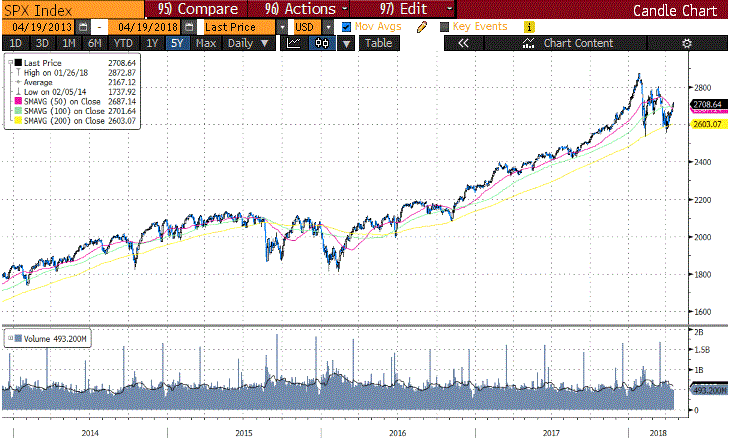A Slice Of Humble Pie
“Pride of opinion has been responsible for the downfall of more men on Wall Street than any other factor.” – Charles Dow
Something’s happening in the markets these days that I can’t quite put my finger on, but it makes me very uneasy. In the last two months the US equity market has fallen by 10%, twice. Volatility came roaring back briefly with a vengeance, Bitcoin plummeted from priceless to near worthless, Facebook’s data breach bludgeoned technology stocks and Trump’s tariff tweets brought renewed fear of a full blown trade war.
And yet as we trudge forward through a rather robust earnings season (79 percent of S&P 500 companies that reported so far have surpassed earnings expectations) things still appear to be intact.
Looking back to the beginning of 2014, the seven largest tech leaders in the US (FAANNGs + Microsoft) have contributed to over half of the 60% increase in the S&P. But this doesn’t seem to have shaken investor future expectations one bit. Earnings expectations remain sky high, perhaps higher than ever before at +30% EPS growth year-over-year and somehow everyone believes that the these companies and the market still have what it takes to meet their lofty requirements.

S&P 500 since 2014; Source: Bloomberg
The market is off-balance at the moment and the bulls just aren’t giving up.
Somehow over the course of the last few years, the market has moved from a place where real facts and fundamentals matter, to a place where subjectivity reigns supreme. Simple investor psychology has shifted (for the worst) and the way in which investors assess risk has changed all together.
The conventional process in investing begins with establishing an investment goal and calculating what the return will be, or identifying an opportunity and determining what the upside is.
The crux of the problem when it comes to assessing investments in this manner, and more specifically the risks associated with said investment, is that risk is the opposite to return — it is not easily quantifiable. Rather, it is a conceptual calculation of how much one can lose and the probability of losing it.
It is far easier (and admittedly a lot more fun) to daydream about the upside of an investment rather than first considering how much one can lose if the proverbial sh1t hits the fan. It’s akin to the old game we like to play of “what would if I won the lottery” only worse because the downside to playing the lottery is clear and limited – the cost of the ticket.
The current risks we are seeing but often times not quantifying in the market have been apparent for quite some time now. I’ve spoken about then ad nauseam over the last year including the usual suspects of indexing, central bank tightening and geopolitical posturing.
But as most seasoned investors know, nothing is ever certain in the financial markets and astute investing all comes down to how one adjusts their framework as more information and evidence comes to light.
As global fund flows tend to be dominated by large institutional investors and quantitative/machine-driven algorithms, the individual investor has an even lower chance of success in today’s market than ever before.
With the dawn of the internet, information (and knowledge) has become extremely commoditized. Everyone’s an “expert” these days and if even if you aren’t, you’re just a Wikipedia article away from being one. Transparency (which in most cases is a good thing) and “access” is freer than it has ever been so for individual investors to have a real edge in the markets you need to graduate to second and third level thinking.
Second level thinking is easier to articulate. It involves developing independent views above and beyond the broad market context. It is proactive and not reactive. If everyone else out there is reading the exact same headlines and reacting in the same manner then second level thinking takes you one step further. By analyzing the data points, the news flow, and the macro implications, how do we make (or lose) money from a certain event? What will the transmission mechanism of a geopolitical event, or a policy misstep be when considering the broader investable universe?
When these stress points occur, investors can take advantage and trade them. Second level thinking is what most “professional” investors attempt to do, but most of them do not continue the process to reach third level thinking. Much of the Sell-Side thrives off of second level thinking, and being able to evaluate investment opportunities based off of news flow or an event and this is exactly what Buy-Side clients pay Wall Street analysts for. And while you can “get by” and make moderate gains playing in the second level, it is unlikely that these gains can be replicated over the long term without advancing to third level thinking.
Third level thinking is more introspective and it requires you to constantly be assessing whether or not your second level view is right, and more specifically the probability that your view is right or not. It requires checking your ego at the door and realizing that everyone at some point or another will be humbled by the markets.
As an investor you need to be systematic when considering this. As markets gyrate and news flow comes and goes, it requires a constant reassessing of probabilities as to whether or not your view is right, or dead wrong. It takes humility to admit you are wrong and the problem with humility is that it tends to have an inverse relationship with success. In the end investing is a constant balance between conviction and humility and only those who recognize this are able to be successful in the end.
Over my long and undistinguished investing career, I’ve learned about humility the hard way…the costly way…many, many a time.
As we continue to drift sideways into uncharted market waters, here’s a pro tip for you: Always consider your risks first. Third level thinking takes a long time to work out and in meantime you can save yourself some money by protecting your downside.

